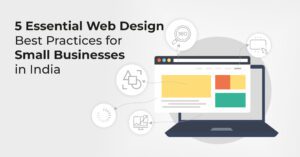In today’s hyper-connected world, your website is often the first—and sometimes the only—interaction a potential customer has with your business. For small businesses in India, a well-designed website can mean the difference between sustainable growth and getting lost in the digital crowd. From the bustling markets of Delhi to the tech hubs of Bengaluru, customers expect not only quality products and services but also an online experience that’s seamless, engaging, and trustworthy.
Yet many small enterprises underestimate the power of effective web design. They focus solely on aesthetics or content, overlooking the user journey, mobile compatibility, and SEO foundations that can drive visibility and conversions. As internet penetration deepens across both metro and rural India, and with mobile devices accounting for over 70% of web traffic, getting your web design right is no longer optional—it’s essential.
In this comprehensive guide, we’ll explore Essential 5 Web Design Best Practices for Small Businesses in India, complete with practical tips, and clear action steps. These strategies will help you build a website that not only looks great but also performs exceptionally—driving traffic, engagement, and ultimately, revenue.
1. Clear Navigation and Intuitive User Experience
Why It Matters
Key Elements of Effective Navigation
- Logical Menu Structure: Group related pages under clear headings (e.g., “Products,” “Services,” “About Us,” “Blog,” “Contact”).
- Breadcrumbs: Help users understand their location within the site hierarchy.
- Visible Call to Action (CTA) Buttons: Ensure primary CTAs (like “Book Now,” “Shop Now,” or “Get a Quote”) stand out—ideally above the fold on every page.
- Search Functionality: For larger catalogs, a search bar with autocomplete enhances usability.
Practical Tips
- Limit primary menu items to 5–7 choices to avoid overwhelming visitors.
- Use clear, action oriented labels (e.g., “Explore Tours” instead of just “Tours”).
- Implement sticky headers so the menu is always within reach as users scroll.
- Conduct simple user testing—ask friends or family to find specific information and note where they struggle.
2. Mobile Responsiveness
Why It Matters
In India, over 60% of internet users access the web via smartphones. A site that looks fantastic on desktop but breaks on mobile can cost you thousands of potential customers. Mobile responsiveness ensures your website automatically adapts layout, images, and navigation to fit any screen size—improving engagement and boosting your Google rankings.
Techniques to Improve Speed
- Image Optimization: Compress images using WebP or AVIF formats and implement lazy loading.
- Minify Assets: Compress CSS, JavaScript, and HTML files to reduce file sizes.
- Leverage Browser Caching: Set proper Cache-Control headers to store static resources locally.
- Use a Content Delivery Network (CDN): Distribute assets across geographically dispersed servers for faster delivery.
Practical Tips
- Run periodic audits with tools like Google PageSpeed Insights and GTmetrix to pinpoint bottlenecks.
- Combine multiple CSS/JS files into single bundles where possible to reduce HTTP requests.
- Prioritize critical CSS (above-the-fold styling) inline, and defer non critical scripts.
- Choose a reliable hosting provider with servers located in or near India for lower latency.
3. Fast Loading Times
Why It Matters
Research shows that 40% of users abandon a page that takes more than 3 seconds to load. In India’s varied network conditions—from 5G in urban centers to 3G in rural areas—load speed can make or break the user experience. Faster sites not only keep visitors engaged but also earn preferential treatment in search engine rankings.
Best Practices for Responsiveness
- Fluid Grids & Flexible Images: Use CSS frameworks like Bootstrap or custom media queries to adjust layouts seamlessly.
- Touch-Friendly Elements: Ensure buttons and links are large enough (minimum 44×44 pixels) and spaced sufficiently to prevent mis-taps.
-
Optimized Media: Serve appropriately sized images using the
element or responsive image attributes. - Viewport Meta Tag: Include <meta name="viewport" content="width=device-width, initial-scale=1.0"> in your section.
Practical Tips
- Regularly test your site on multiple devices and use Google’s Mobile-Friendly Test tool.
- Prioritize “mobile-first” design—start your layout for the smallest screens and scale up.
- Simplify navigation on mobile by using hamburger menus and accordions for submenus.
- Eliminate non essential elements (like large hero videos) that can slow down mobile load times.
4. Effective Use of Visuals and Branding
Why It Matters
Visual & Branding Guidelines
- Consistent Color Palette: Select 2–3 primary brand colors and complementary accent hues; use them consistently across buttons, headings, and icons.
- Typography Hierarchy: Pair a clear, web safe font for body text (e.g., Open Sans, Roboto) with a distinctive heading font to enhance readability and style.
- High Quality Imagery: Use professional photos or carefully curated stock images that reflect your products, team, or workspace.
- Whitespace & Layout: Embrace whitespace to draw attention to key elements and prevent visual clutter.
Practical Tips
- Create a simple brand style guide (even a one page PDF) documenting your logo usage, colors (with HEX codes), and typography rules.
- Use tools like Canva or Figma to mock up page layouts before development.
- Incorporate authentic visuals—behind-the-scenes shots or customer photos—to build emotional connection.
- Ensure all images are optimized for web (see loading times section) to maintain speed.
5. Basic Search Engine Optimization (SEO)
Why It Matters
SEO isn’t just for big enterprises. For small businesses in India, ranking on Google for local searches like “best café in Pune” or “affordable SEO services Mumbai” can drive targeted traffic without hefty ad spends. Implementing foundational SEO practices ensures search engines can find, index, and rank your site for relevant queries.
Core SEO Best Practices
- Keyword Research: Identify long tail keywords with local intent (e.g., “handcrafted sarees Kolkata”).
- On Page Optimization: Include target keywords in title tags, meta descriptions, headings (H1, H2), and alt text for images.
- Clean URLs: Use descriptive, hyphenated URLs (e.g., yourdomain.com/cbridal-jewelry) instead of query strings.
- Internal Linking: Link related pages within your site to establish content hierarchy and distribute link equity.
- Local SEO: Claim and optimize your Google Business Profile, ensure NAP (Name, Address, Phone) consistency, and gather genuine customer reviews.
Practical Tips
- Use free tools like Google Keyword Planner or Ubersuggest for keyword discovery.
- Install an SEO plugin (e.g., Yoast SEO for WordPress) to guide on-page optimization.
- Regularly monitor rankings and organic traffic with Google Search Console and Analytics.
- Encourage satisfied customers to leave reviews on Google and social media; respond promptly to feedback.
Practical Tips for Small Business Owners
1. Start Small, Iterate Often
- Launch with core functionality and essential pages. Gather user feedback and analytics data to guide incremental improvements.
2. Leverage Affordable Tools
- Use website builders like WordPress, Wix, or Squarespace for quick setups. Many offer built in themes optimized for SEO and mobile responsiveness.
3. Prioritize User Feedback
- Add a simple feedback widget or conduct brief email surveys post purchase. Real user insights are invaluable for refining your UX and content.
4. Monitor Performance Metrics
- Track key metrics—page load times, bounce rate, session duration, conversion rate—using Google Analytics. Set up monthly reviews to spot trends.
5. Outsource Strategically
- For complex tasks like SEO audits or custom development, consider hiring freelancers or small agencies. Platforms like Upwork and Freelancer offer access to vetted talent at competitive rates.
6. Stay Updated
- Web technologies evolve rapidly. Subscribe to blogs like Smashing Magazine, Moz, or W3Schools to keep abreast of design trends, performance hacks, and SEO algorithm changes.
Conclusion
Remember: effective web design is an ongoing journey, not a one time project. Start by auditing your current site against these five best practices, set measurable goals, and iterate based on real data and user feedback. With a strategic, user focused approach, your website can become your most powerful marketing and sales tool—propelling your small business toward sustained success in India’s ever expanding digital economy.




